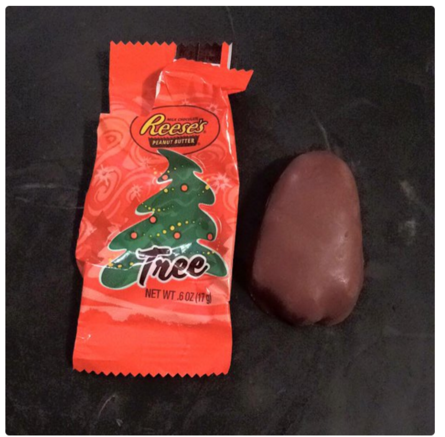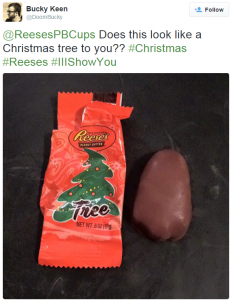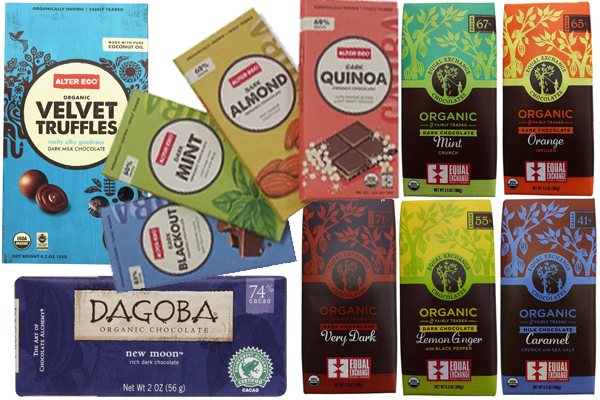The Real Reason To Be Upset With Reese’s Chocolate (It Has Nothing to Do With the Shape of Their Trees)
By
While some people on Twitter have shared that they were upset about the shape of the seasonal Reese’s Peanut Butter Cups “Trees” because they do not look like trees, there is an actual reason to be upset with Hershey’s, the company that makes Reese’s, and with other big chocolate manufacturers. There are so many additives in their products that they’re robbing us of real chocolate! It has been greatly substituted by PGPR (polyglycerol polyricinoleate) – a yellow gooey liquid, an emulsifier that helps create very “low cost chocolate.”
“Cocoa butter is an expensive raw material for chocolate manufacturers. By using [a highly concentrated PGPR] the chocolate recipe has lower costs in terms of less cocoa butter…” states the emulsifier company Palsgaard (which has factories in Denmark, China, Mexico and more) about their product PALSGAARD 4150.
Palsgaard call themselves experts in emulsifiers and stabilizers. Besides Palsgaard, PGPR is made by Danisco, which is now owned by one of the biggest chemical companies, DuPont.
This “viscosity-reducing” concoction is manufactured from polymerized glycerol and polymerized ricinoleic acid, in a three-step process undertaken by Palsgaard and other companies. It is often made using castor beans or possibly soybean oil, and paired with yet another emulsifier, soy lecithin, in order to make a cheaper chocolate bar that can be mass-produced and then sold to unsuspecting customers.
Widget not in any sidebars
The main reason for using PGPR? — It makes it possible for companies to make more “chocolate” without actually using more cocoa.
The Food and Drug Administration (FDA) allows a daily intake of 7.5 milligram of PGPR per kilogram of body weight, therefore PGRA is called GRAS – “generally recognized as safe.” In the UK, the limit is set at 2.64 milligrams. How much PGPR is in Hershey’s chocolate? They will not disclose because they do “not reveal [the] product formulas,” according to their website.
There has been one study that showed an “increase in liver and kidney weight” in rats when consuming PGPR for 80 weeks and for 2 years. The side effect was however written off as a probable result of increased liver workload.
While not proven unhealthy, there are no health benefits to PGPR, while we are being cheated of health benefits of cocoa butter, cacao and other actual chocolate products. The more cocoa butter there is in the chocolate bar, the better it is for you! Cocoa beans are high in antioxidants. Real dark chocolate improves heart and brain health, and helps lower blood pressure and cholesterol.
Better Choices When It Comes to Chocolate
Besides PGPR other ingredients that are better off avoided are: dyes such as Red #50 (linked to behavior problems in children), carrageenan, artificial flavors, preservatives, GMOs and of course, high fructose corn syrup. Reese’s products contain several ingredients that are extremely likely to be genetically engineered including: GMO beet sugar, dextrose and other corn derivatives, and milk from cows that have been fed GMOs.
As you may have guessed, there are far better options when it comes to chocolate.
Natural & Healthy Organic Snacks. Up to 50% Off – Every Day (Ad)
Some companies that make organic, fair-trade or health-conscious chocolate with unique, creative flavors are:
Alter Eco – USDA organic, fair-trade, and gluten free. Besides chocolate bars, they make truffles.
Dagoba – organic (not-certified), gluten-free, uses GMO-free soy. Some unusual flavors include lavender blueberry, chili, raspberry with rosehip, and chai. Dagoba is owned by Hershey’s however, so you’re better off buying from smaller companies to support the real food movement.
Equal Exchange – – USDA organic, fair-trade, and Kosher certified. They also make hot cocoa.
Sacred Chocolate – Organic and packed with high quality cacao and low glycemic index sweeteners like maple sugar and coconut sugar, this is one of the healthiest chocolate bars you can buy. It’s also quite pricey, however, so you may be better off making your own at home using a quality cacao powder like Joyfuel and sweeteners like local raw honey.
See: No-Bake Chocolate Coconut Oil Patties
This article appeared first at AltHealth Works where you can find more provocative and investigative reporting on health topics that matter to you. The alternative health movement will be mainstream soon! Like on Facebook, follow on Twitter





